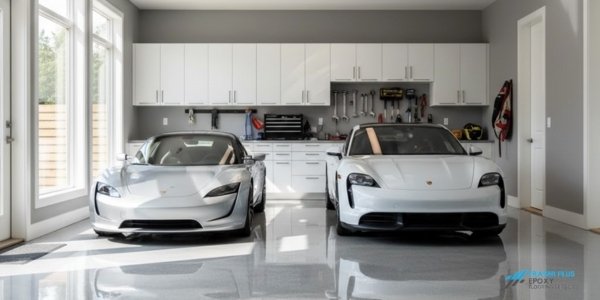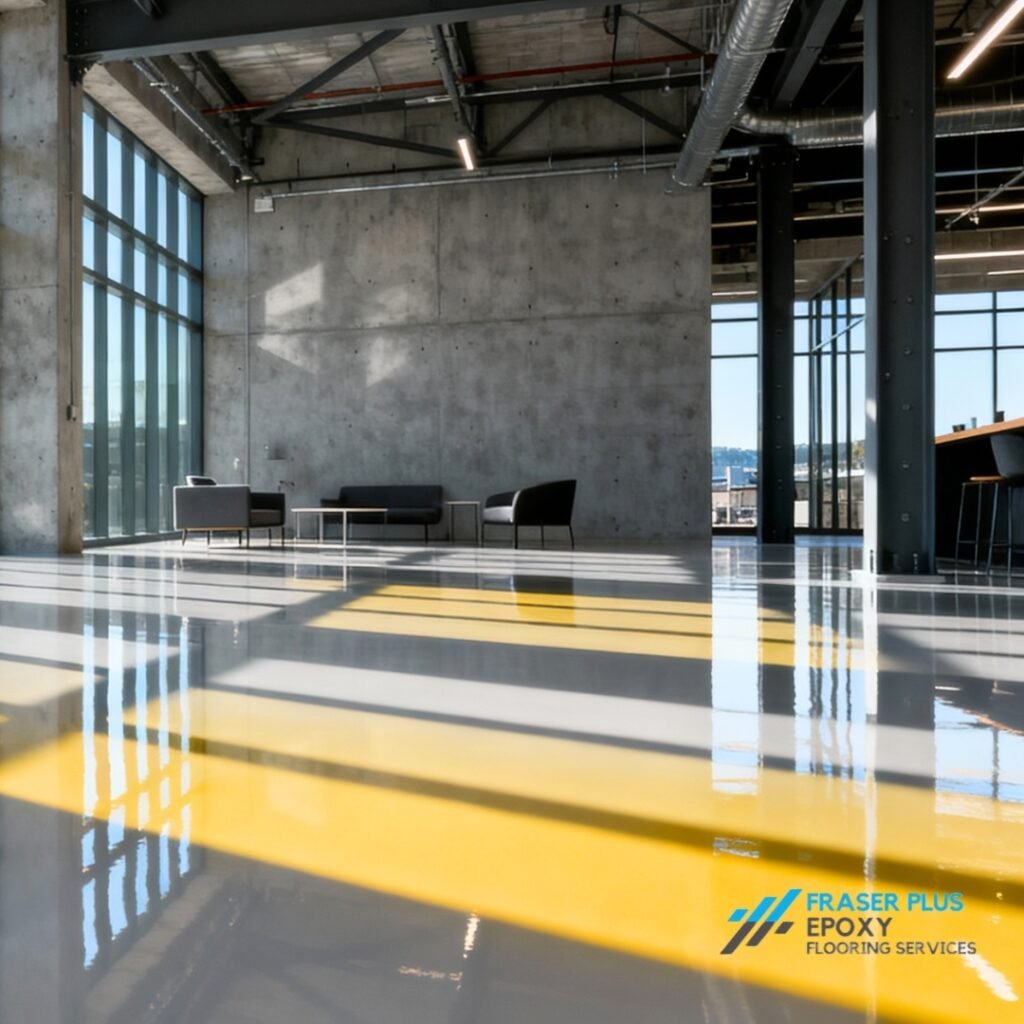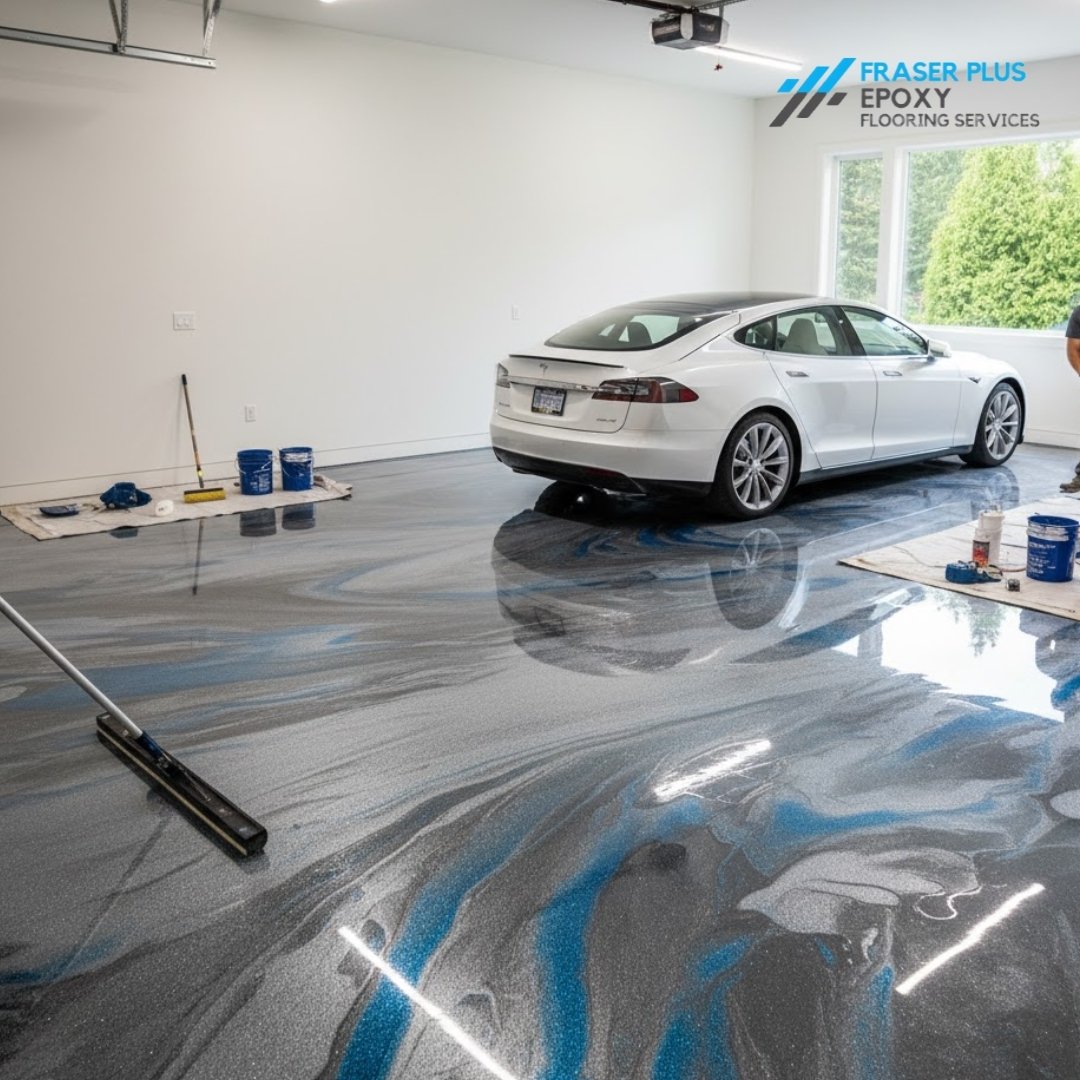Picture this scenario: You invested $8,000 in beautiful new epoxy flooring Vancouver garage last year. The glossy finish looked stunning, transforming your space into something you were proud to show off. Fast forward twelve months, and those areas near your garage doors and windows have developed an unsightly yellow tint that grows more pronounced each day. Sound familiar? You’re not alone—UV damage and yellowing represent the #1 complaint among Vancouver epoxy floor owners, but here’s the good news: it’s completely preventable with the right knowledge and materials. In 2025, the flooring industry has revolutionized UV protection with advanced polyaspartic coatings and hybrid systems that maintain their crystal-clear appearance even after years of direct sunlight exposure.
Vancouver’s unique climate—with its abundant natural light, seasonal temperature swings, and high humidity levels—creates specific challenges that require specialized solutions. The difference between a floor that yellows within two years and one that maintains its pristine appearance for decades comes down to understanding UV damage mechanics, selecting appropriate materials for Vancouver’s environment, and implementing proven protection strategies. Fraser Plus Epoxy has witnessed firsthand how the right approach eliminates costly repairs and maintains stunning results that increase property value year after year.
Understanding UV Damage: Why Epoxy Flooring Vancouver Yellow and Fade
UV damage isn’t just about aesthetics—it’s a chemical process that fundamentally alters your epoxy flooring at the molecular level. Understanding this process is crucial for preventing damage and selecting the right protection strategies for Vancouver’s specific environmental challenges.
The science of epoxy yellowing begins with UV radiation breaking down the chemical bonds in traditional epoxy resins. When ultraviolet light penetrates the coating, it triggers oxidation reactions that create yellowish compounds called chromophores. These aren’t surface stains you can clean away—they’re permanent molecular changes that require complete coating removal and replacement to correct.
Vancouver’s unique UV challenges compound this problem. Our city receives an average of 1,928 hours of bright sunshine annually, with particularly intense UV exposure during summer months when garage doors stay open and large windows flood spaces with natural light. Unlike interior spaces with artificial lighting, garages and commercial areas with significant window exposure face continuous UV bombardment that accelerates yellowing in traditional epoxy systems.
Temperature cycling accelerates degradation in Vancouver’s climate. Our temperature swings from winter lows around 0°C to summer highs above 25°C cause epoxy coatings to expand and contract repeatedly. This mechanical stress creates micro-cracks that allow deeper UV penetration, accelerating the yellowing process and reducing the coating’s protective capabilities.
Humidity factors also play a role. Vancouver’s high humidity levels can increase the rate of chemical reactions that contribute to yellowing, particularly when combined with UV exposure. Moisture trapped within the coating system creates ideal conditions for accelerated degradation, especially in areas with limited ventilation like closed garages or storage facilities.
The cost of UV damage extends beyond appearance. Yellowed epoxy floors lose their protective properties, becoming more susceptible to staining, chemical damage, and wear. Property values decrease, maintenance costs increase, and eventual replacement becomes necessary years earlier than properly protected floors. Understanding these mechanisms helps Vancouver homeowners and business owners make informed decisions about UV protection strategies.
Revolutionary Polyaspartic Solutions of Epoxy Flooring Vancouver
The flooring industry has witnessed a revolutionary shift in 2025, with polyaspartic coatings emerging as the definitive solution for UV-resistant flooring in Vancouver. These advanced coatings don’t just resist yellowing—they maintain their crystal-clear appearance indefinitely, even under direct sunlight exposure.
Polyaspartic molecular structure provides inherent UV stability that traditional epoxy simply cannot match. Unlike epoxy resins that contain aromatic compounds susceptible to UV degradation, polyaspartic coatings utilize aliphatic chemistry that remains stable under ultraviolet radiation. This isn’t just improved UV resistance—it’s complete immunity to yellowing under normal exposure conditions.
Rapid curing advantages make polyaspartic coatings particularly attractive for Vancouver applications. While traditional UV-resistant epoxy systems require 3-7 days to fully cure, polyaspartic coatings achieve full strength in 24-48 hours. This means your Vancouver garage can be back in service over a weekend rather than being out of commission for an entire week.
Superior performance characteristics extend beyond UV resistance. Polyaspartic coatings demonstrate exceptional abrasion resistance, chemical resistance, and flexibility—crucial qualities for Vancouver’s climate extremes. They maintain glossy finishes even in high-traffic areas and resist the micro-cracking that can plague rigid epoxy systems during temperature cycling.
Hybrid system innovations represent the cutting edge of 2025 flooring technology. These systems combine epoxy base coats for adhesion and economics with polyaspartic topcoats for UV protection and durability. Fraser Plus Epoxy has installed hundreds of these hybrid systems across Vancouver, achieving the cost-effectiveness of epoxy with the long-term performance of polyaspartic protection.
Environmental benefits align with Vancouver’s sustainability goals. Modern polyaspartic coatings feature low-VOC formulations that improve indoor air quality without sacrificing performance. They also eliminate the need for frequent recoating cycles, reducing long-term environmental impact and lifecycle costs.
Investment protection becomes paramount when you consider the numbers. A high-quality polyaspartic system might cost 20-30% more initially than traditional epoxy, but it eliminates yellowing-related replacement costs that can reach $15,000-25,000 for typical Vancouver installations. The return on investment through extended service life and maintained appearance makes polyaspartic coatings the smart choice for discriminating property owners.
Proven Protection Strategies: Beyond Just Coating Selection
Even the best UV-resistant coatings benefit from additional protection strategies that maximize longevity and maintain pristine appearance. Smart Vancouver property owners implement comprehensive approaches that address UV exposure from multiple angles.
Strategic window treatments can dramatically reduce UV exposure in spaces with significant natural light. UV-filtering window films block harmful radiation while maintaining visibility and natural lighting. These films can reduce UV transmission by 95-99%, providing substantial protection for floor coatings while potentially reducing cooling costs during Vancouver’s sunny summer months.
Intelligent lighting design complements UV protection strategies. LED lighting systems eliminate UV output entirely while providing superior illumination for garages and commercial spaces. Unlike fluorescent or halogen lighting that can contribute to coating degradation, LEDs actually help preserve floor appearance while reducing energy costs.
Regular maintenance protocols extend coating life regardless of UV resistance levels. Monthly cleaning with pH-neutral cleaners removes contaminants that can accelerate degradation. Quarterly inspections identify potential issues before they become costly problems. Annual professional assessment ensures coating systems maintain optimal performance and appearance. This research paper demonstrates that TiO2 coatings fabricated via advanced methods can effectively protect polymers from UV degradation by blocking over 99% of harmful UV light, significantly improving polymer stability against UV irradiation without compromising transparency. It provides evidence-based details on UV shielding mechanisms relevant to protective coatings technology, which underpins the UV resistance benefits discussed for epoxy and polyaspartic floor coatings.
Environmental controls address the broader factors that influence coating longevity. Proper ventilation reduces humidity levels that can accelerate chemical degradation. Temperature control minimizes extreme cycling that stresses coating systems. These measures benefit both UV-resistant epoxy and polyaspartic installations.
Protection during high-risk periods proves particularly valuable in Vancouver. During summer months when UV exposure peaks, consider temporary shading for areas receiving direct sunlight through open garage doors. Simple measures like parking vehicles to provide shade or using portable screens can significantly reduce UV load on vulnerable floor areas.
Documentation and warranty protection ensure long-term value. Maintain records of cleaning, maintenance, and any environmental factors that might affect coating performance. Understand warranty terms and conditions, particularly regarding UV exposure and maintenance requirements. Fraser Plus Epoxy provides comprehensive documentation and warranty support for all polyaspartic installations, giving clients confidence in their investment protection.
Cost Analysis: UV Protection ROI in Vancouver’s Market
Property value maintenance represents another crucial factor. Real estate professionals report that yellowed, degraded epoxy floors actually detract from property values, while pristine floors add $2-4 per square foot to home valuations. For Vancouver’s competitive housing market, this translates to $1,000-2,000 in maintained property value for typical garage installations.
Commercial applications demonstrate even more compelling economics. A 2,000-square-foot commercial space with traditional epoxy might face $25,000-35,000 in replacement costs when yellowing becomes unacceptable to customers or employees. Polyaspartic installations eliminate these business disruptions while maintaining professional appearance throughout the coating’s service life.
Energy efficiency benefits add unexpected value. UV-resistant coatings with high reflectivity can reduce lighting requirements and cooling loads in commercial applications. While modest, these operational savings compound over decades of service life, further improving the investment equation for UV-protected flooring systems.
Fraser Plus Epoxy’s analysis of over 200 Vancouver installations shows that UV-resistant systems typically achieve payback within 7-10 years through avoided replacement costs alone. When property value maintenance and reduced maintenance requirements are included, payback periods shrink to 4-6 years for most applications.
Future-Proofing Your Investment: What Vancouver Property Owners Need to Know

As Vancouver’s building standards evolve and environmental awareness increases, property owners who invest in UV-resistant flooring systems position themselves ahead of emerging trends and requirements.
Building code evolution increasingly emphasizes long-term durability and environmental responsibility. While current codes don’t mandate UV-resistant flooring, emerging standards favor materials with extended service life and reduced replacement frequency. Early adoption of polyaspartic systems aligns with these developing requirements.
Insurance and liability considerations are gaining importance in 2025. Some insurance providers offer premium discounts for properties with documented long-term maintenance strategies. UV-resistant flooring systems, with their extended warranties and predictable performance, can contribute to these risk reduction programs.
Technology integration opportunities emerge with smart flooring systems that monitor performance and environmental conditions. Advanced coatings can incorporate sensors that track UV exposure, temperature cycling, and wear patterns, providing data for optimal maintenance scheduling and warranty protection.
Environmental compliance trends favor systems with longer service lives and lower replacement frequency. As Vancouver strengthens its environmental regulations, materials that reduce waste and disposal requirements become increasingly valuable. Polyaspartic systems align with these sustainability goals while delivering superior performance.
Market differentiation advantages benefit property owners who maintain pristine flooring systems. Whether selling residential property or operating commercial space, floors that maintain their appearance throughout ownership create competitive advantages in Vancouver’s demanding market.
Professional installation importance cannot be overstated for UV-resistant systems. While DIY approaches might seem cost-effective, the specialized knowledge required for proper UV protection makes professional installation essential. Fraser Plus Epoxy’s certified installers understand Vancouver’s specific challenges and ensure optimal performance from advanced coating systems.
Fraser Plus Epoxy | Epoxy Flooring Vancouver Contractor
UV damage and yellowing are completely preventable with modern polyaspartic coatings and proper protection strategies designed for Vancouver’s unique environment. While the initial investment in UV-resistant systems exceeds traditional epoxy costs, the long-term savings through avoided replacements, maintained property values, and superior performance make it the smart choice for discerning property owners who want floors that look stunning for decades, not years.
Protect your Vancouver epoxy floors today—contact Fraser Plus Epoxy for expert UV-resistant solutions that guarantee long-lasting, pristine results.
FAQs
1. What makes polyaspartic coatings more UV resistant than traditional epoxy?
Polyaspartic coatings contain aliphatic chemistry that provides inherent UV stability, preventing yellowing and fading even after prolonged sun exposure, unlike traditional epoxy which contains aromatic compounds more susceptible to UV degradation. This makes polyaspartic systems a superior choice for outdoor and sunlit Vancouver spaces.
2. How often should I recoat or maintain UV-resistant epoxy floors?
UV-resistant floors like polyaspartic coatings typically require less frequent maintenance than traditional epoxy. Regular cleaning and inspections every 6-12 months can help maintain their appearance, with professional evaluations recommended every few years to ensure optimal protection.
3. Can UV protection be added to existing epoxy floors?
Yes, many flooring specialists can apply a UV-protective topcoat or overlay to existing epoxy floors to restore their appearance and prevent yellowing. Consulting with a professional ensures proper product selection and application for long-lasting results.
4. How does environmental control affect the longevity of epoxy flooring in Vancouver?
Controlling humidity, temperature fluctuations, and ventilation can significantly extend epoxy flooring life. Proper environmental management reduces mechanical stress and chemical reactions that contribute to degradation, especially in Vancouver’s high-humidity climate.
5. Why should I choose professional installation for UV-resistant epoxy coatings?
Professional installers have the expertise to ensure correct surface preparation and optimal coating application, which are crucial for UV protection and durability. Proper installation maximizes the lifespan and appearance of your epoxy floors, avoiding common issues like micro-cracking and premature yellowing.
People Also Ask
1. Does UV protection impact the cost-effectiveness of epoxy flooring in Vancouver?
While UV-protected coatings may have a higher initial cost, they significantly reduce long-term expenses related to maintenance, repairs, and replacement, providing a better return on investment over the lifespan of your floors.
2. How does Vancouver’s climate influence the choice of epoxy flooring systems?
Vancouver’s seasonal temperature swings, high humidity, and intense sunlight demand coatings with superior flexibility, chemical resistance, and UV stability—making polyaspartic systems especially suitable for the environment.
3. Can UV-resistant coatings be eco-friendly?
Yes, many modern polyaspartic coatings feature low-VOC formulations that improve indoor air quality and reduce environmental impact while delivering high performance and durability.
4. What is the typical lifespan of UV-resistant epoxy floors in Vancouver?
With proper protection and maintenance, UV-resistant epoxy floors like polyaspartic systems can last 15-20 years, far exceeding the 5-8 years typical of traditional epoxy exposed to Vancouver’s sunlight.
5. How can I tell if my epoxy floor needs UV protection?
If your epoxy floor is exposed to direct sunlight through windows or garage doors and shows signs of yellowing or fading, adding UV protection or replacing worn coatings with UV-resistant systems should be considered.
TAGS: Vancouver epoxy flooring, UV-resistant epoxy floors, prevent epoxy yellowing, polyaspartic coatings Vancouver, epoxy floor protection



